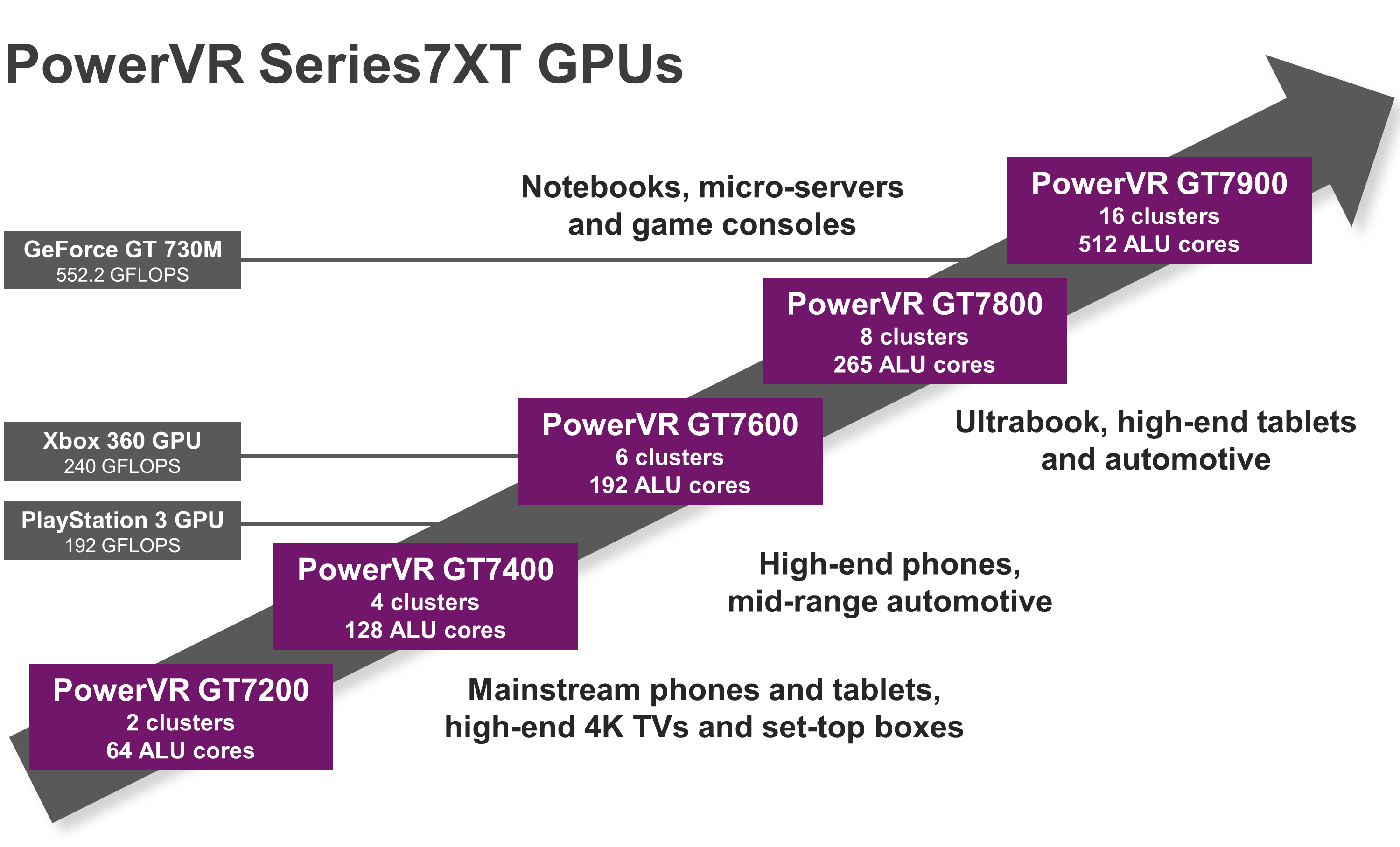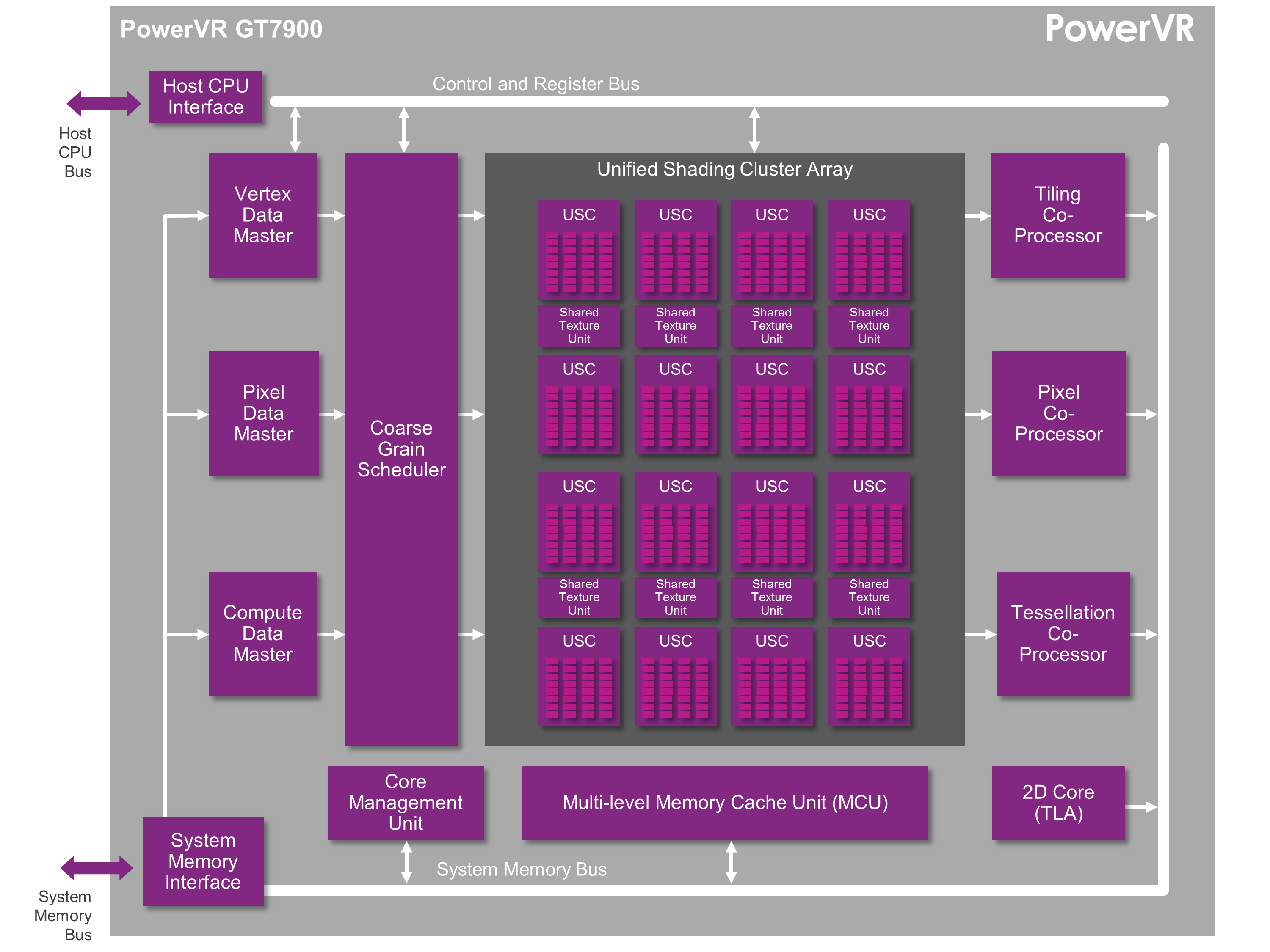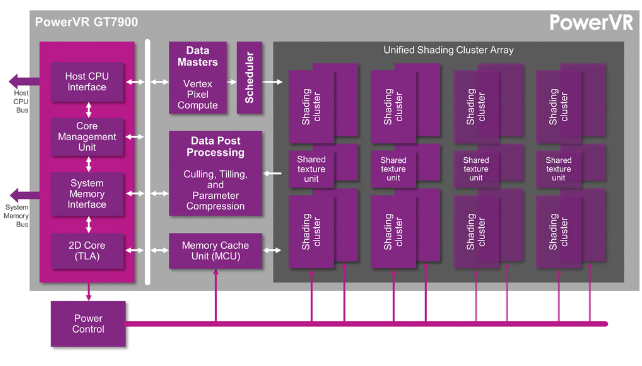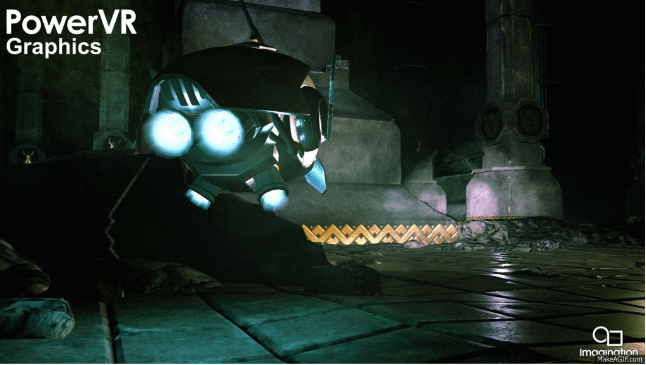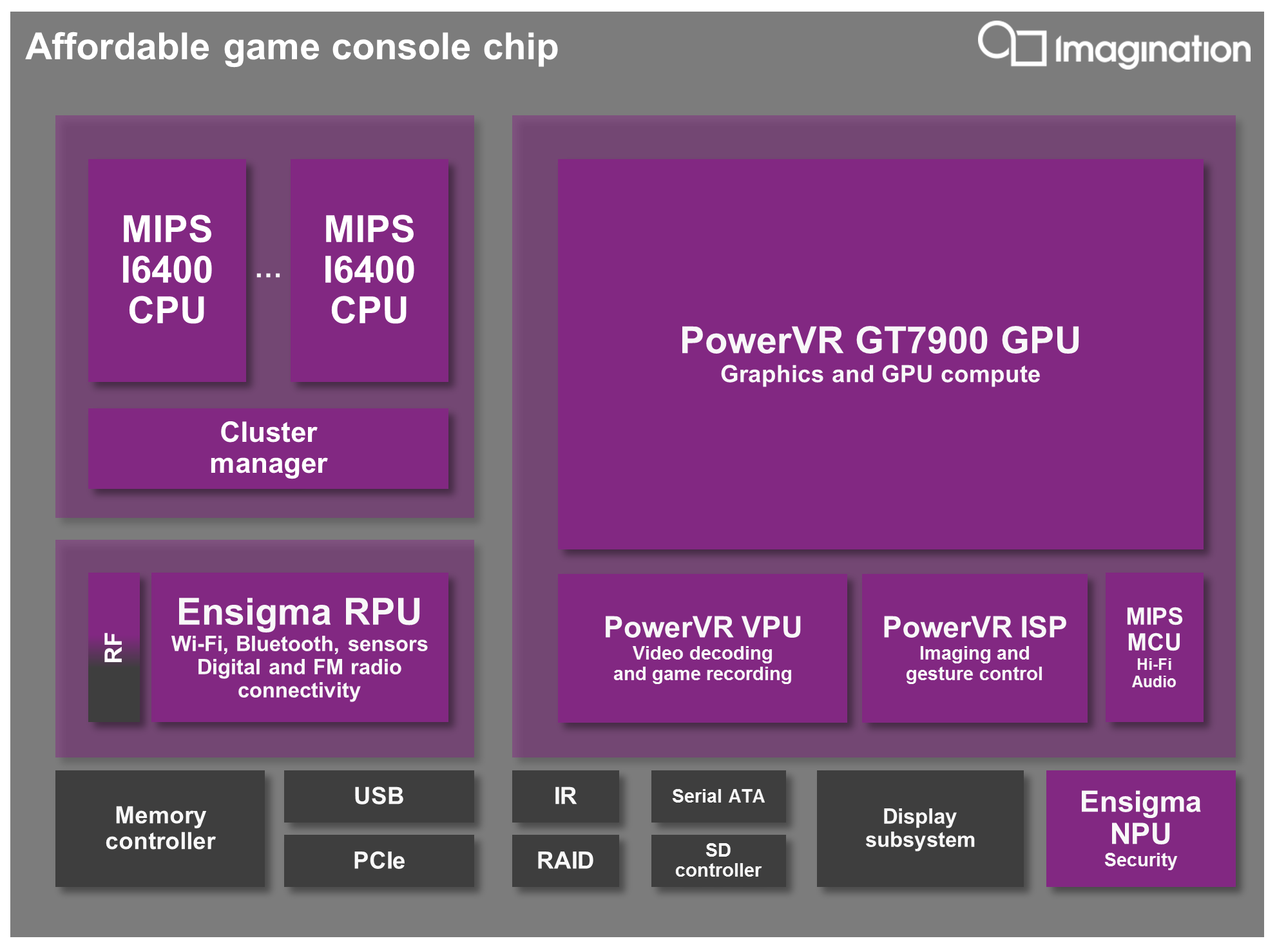Imagination Eyes Low-Cost Android Consoles With High-End PowerVR GT7900 GPU
Today, Imagination Technologies announced its new top of the line mobile GPU and successor to the PowerVR GX6650, the PowerVR GT7900.
The new GPU comes with 2.6x more ALUs than the GX6650, which is 512 "cores" in total, combined in 16 Unified Shader Clusters. The GX6650 had only 192 ALUs and six clusters. This will give the GT7900 more than triple the performance of the GX6650.
Imagination expects the higher performance to be kept in check by the transition to the newer 14nm and 16nm FinFET process nodes later this year. Also, this new GPU is mainly targeted at inexpensive mini-consoles (such as Android TVs), which could afford extra cooling compared to a mobile phone or tablet.
The PowerVR GT7900 aims to bring "PC-class" gaming with powerful hardware and support for the OpenGL ES 3.1 graphics API and the Android Expansion Pack (geometry shaders, tessellation, ASTC LDR and HDR texture compression standards, and so on).
Imagination also added hardware virtualization inside the GT7900 GPU so it can support multiple operating systems without a drastic hit in performance. This feature could be especially useful for enterprise customers who want to keep personal environments separated from work environments, even on mobile devices. The feature can be found in Imagination's MIPS Warrior CPU, as well.
Even though most CPU or GPU designers these days focus on "burst" or "turbo" speeds that win popular mobile benchmarks, which run for only a few minutes, which isn't enough time to really heat up the device, Imagination seems to remain focused on sustained performance. Fortunately, when it comes to gaming, sustained performance is really all that matters. If a GPU or CPU can only run at its full advertised speed for 5-10 minutes, and then its performance drops by half in order to keep the device's internals from melting down, that doesn't provide a very good user experience.
A new feature that came with the Rogue architecture is PowerGearing. This is a saving mechanism that automatically shuts off parts of the GPU in power-constrained applications. In other words, the GPU's performance will only be activated as needed, rather than the whole GPU being fully activated at all times and consuming more power.
Get Tom's Hardware's best news and in-depth reviews, straight to your inbox.
Just like Nvidia's Tegra X1, Imagination brings a bigger focus on the high-performance/low-power FP16 mode that can reach up to 1.6 TFLOPS. The GT7900 GPU can reach 800 GFLOPS in the FP32 mode.
All the new GPUs being announced right now will feature (true) 4k support, and the PowerVR GT7900 is not missing this feature either. In fact, the GT7900 is the second PowerVR generation to support 10-bit YUV color support, which is an essential part of the UHD/4k standard. Imagination's new GPU can also easily handle 4k video playback at a smooth 60 fps.
Imagination also offered a sneak peek at the Dwarf Hall console demo, which is to be fully unveiled at GDC this year. Some of the effects in the Dwarf Hall demo include:
1 million triangles per frame in some scenesDeferred shading with 128-bit physically-based G-bufferMany dynamic lightsMultiple specular probes treated as lightsSoft particlesLens flare effectsFull post-process pipeline with color correction, saturation, dynamic exposure and HDR tonemapping
System makers interested in building an affordable console with PC-class gaming and true 4k video playback support could buy the full SoC solution from Imagination, which includes:
a main dual-threaded processor quad-core I6400 MIPS CPU that's organized in two clusters and supports Android 5.0 Lollipopthe new PowerVR GT7900 GPU PowerVR Series5 video encode and decode processors (VPU)PowerVR V2500 camera processor (ISP)Hi-Fi audio microcontrolleran Ensigma radio processor which includes 2x2 MIMO 802.11ac Wi-Fi, Bluetooth 4.0 (and Bluetooth Smart/LE) and digital radio Ensigma security module other components as needed
Imagination is advertising its new PowerVR GT7900 GPU for the 14/16nm FinFET process nodes, which will only be available later this year. That means products that will include the GT7900 will only begin shipping late this year. More information will be revealed at MWC next week.
Follow us @tomshardware, on Facebook and on Google+.
Lucian Armasu is a Contributing Writer for Tom's Hardware US. He covers software news and the issues surrounding privacy and security.
-
tastyKake This is cool, but I feel like these companies miss the point of "performance". That's impressive that the design can handle 1million tris on a mobile chip, I mean I remember making models for games that were less than 1k polys about just 10 years ago, but I feel as if the demos they show prove that they can draw the scenes, which is impressive, but at equally unimpressive frame rates. It's up for debate but I think the main focus should be a smooth 60fps becnhmark instead of how many polys it can handle or the lights in a scene etc. They understand that for video with 4k@60fps, so please extend that to real 3D performance.Reply -
TallestJon96 Mobile parts are making excellent progress, but I have to wonder how much the power will actually be used. Tablets can use more than phones, and an android console is interesting, but I don't think that will get much momentum.Reply
With this rapid progress we could have an interesting situation where by the end of the PS4 generation mobile systems, especially tablets will have more power and higher resolution for games than the consoles do. -
iam2thecrowe ReplyScale it to size of discrete cards we have in desktops would be nice.
I agree it would be good to see PowerVR get back in the pc gpu game again to split up AMD and Nvidia. -
dragonsqrrl "The PowerVR GT7900 aims to bring "PC-class" gaming with powerful hardware and support for the OpenGL ES 3.1 graphics API"Reply
That made me laugh a little. -
alextheblue Reply"The PowerVR GT7900 aims to bring "PC-class" gaming with powerful hardware and support for the OpenGL ES 3.1 graphics API"
That made me laugh a little.
Yeah. However keep in mind that the article doesn't mention that these GPUs are available with optional support for DX 11.2 and OGL 4.3. They don't include this in the base configurations because Android uses OGL ES + AEP which is supported by default. However, it is available if you wanted it for your device.
Anyway, yeah I would kind of like to see them make a return to discrete PC graphics... but it's difficult to justify the attempt. You're going to have a hard time competing with the value of integrated graphics on the low end, and you'll have an uphill battle against the price and performance of existing discrete graphics solutions. So while I think it would be interesting, from a financial point of view it doesn't make sense to spread their limited resources out further at this time. -
somebodyspecial This will be facing the 14nm Nvidia X1 replacement chip later this year for xmas, so already going to be behind. I'd expect Nv to double their 512 FP32 and 1024 FP16 numbers of X1 when they go to samsung in Q2/Q3. Samsung says mass production of qcom/nvidia in Q2, so they'll be in xmas stuff just like this chip. Everyone is now facing NV's gaming drivers/discrete tech and developers gaming experience with that tech far before others on PC's. No comment on phones here, that part remains to be seen, but I see larger formats as Nvidia's to lose from here on out. Gaming is taking over mobile, and I don't see how a company like IMG.L (who was forced to mobile ages ago by AMD/NV) can dominate gaming anything (same for Qcom etc).Reply
I hope AMD gets in this soon, or at least by the time games are being aimed squarely at X1 level gpus and above on mobile. They need to get out a great 14/16nm SOC for arm and reap the benefits with NV on gaming finally moving up to console/pc like stuff on mobile. It's far easier to port to the exact same chip on a PC where you made your game, to mobile that uses a chip with every feature of the big brother, just scaled down. IE, devs have been using maxwell for ages (in gpu terms anyway...LOL), so they don't have anything new to learn to port a pc game to X1 (or something AMD would put out based on their current tech). I definitely don't see myself buying an xbox1/ps4 knowing 14nm chips hit at xmas. That is already enough power to blow away an xbox360/ps3 game and would be good enough to skip consoles this time for most. We should start getting some really good ports or new content that looks/plays great on mobile soon (say, xmas and after).
I have a PC for real gaming ;) But would rather buy mobile at 14nm for another side to play that always has very cheap games compared to consoles $60. I hope devs port PC/console games like mad and that cash is used to pave the way for NEW IP content on mobile. At 14nm even junkers will be K1 level gpu wise and that should be a nice audience for devs to shoot at with a fairly powerful common gpu level. Most games out there now on mobile were not aimed at anything above Tegra4 levels and many already are pretty great. It's only going to get better now that they will all be OpenGL3.2 ES etc...These things are certainly gaining abilities fast (h265 etc). -
bit_user Reply
I dunno about that. The fastest tablets on the market in 2013 weren't faster than a PS3.15378892 said:With this rapid progress we could have an interesting situation where by the end of the PS4 generation mobile systems, especially tablets will have more power and higher resolution for games than the consoles do.
It's just hard to overcome power constraints. The fact that they're not even targeting this GPU at tablets, and yet it has less than half the raw compute performance of a PS4 (and certainly less than half the memory bandwidth) makes me think that even at 10 nm, they won't be reaching PS4 performance levels in a tablet power envelope.
What you're talking about is matching the performance in just a couple percent of the power consumption. That's a tall order, much inside of a decade. But who knows, maybe better battery technology will enlarge tablets' power envelopes enough to make it happen.
-
bit_user Reply
I don't know which point you're laughing about. Based on the specs, it sounds comparable to an entry-level discrete GPU card. So, technically, you could call it PC-level gaming. But OpenGL ES probably means it'll be a fair porting effort, for any PC or console game.15381231 said:"The PowerVR GT7900 aims to bring "PC-class" gaming with powerful hardware and support for the OpenGL ES 3.1 graphics API"
That made me laugh a little. -
bit_user Reply
Really? What other chips have doubled between 20 nm and 14? When have GPUs ever doubled in a single generation (if you compare cards with equivalent TDP)?15382479 said:This will be facing the 14nm Nvidia X1 replacement chip later this year for xmas, so already going to be behind. I'd expect Nv to double their 512 FP32 and 1024 FP16 numbers of X1 when they go to samsung in Q2/Q3.
I doubt this. While X1 might support DX12 & OpenGL 4.5, Android doesn't. That means a pretty substantial port. Also, the parameters of any mobile chip are going to differ from its PC and console cousins, which will require significant tuning (as will the smaller screen size). And NV doesn't have such a big chunk of the mobile market that developers can specifically optimize for it - most will be aiming for a far lower common denominator, meaning much of the X1's power will probably go to waste.15382479 said:It's far easier to port to the exact same chip on a PC where you made your game, to mobile that uses a chip with every feature of the big brother, just scaled down. IE, devs have been using maxwell for ages (in gpu terms anyway...LOL), so they don't have anything new to learn to port a pc game to X1
